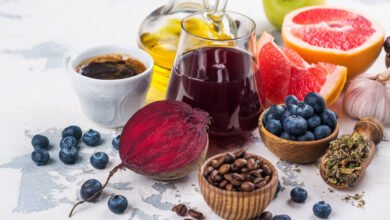Can Diet Improve Chronic Pain?

Living with chronic pain on a daily basis is both physically and mentally taxing. While pain medication may help, lifestyle interventions can also play a role and should be included in a comprehensive and interdisciplinary approach to treating chronic pain.
One component that is often missed: your diet. There is a connection between chronic pain and nutrition, a modifiable behavior that evidence suggests can help you manage pain. In fact, the foods you eat—and choose not to eat—can play a role in decreasing pain. Here’s what you need to know about chronic pain and diet.
Understanding Chronic Pain
Chronic pain can occur in any part of your body and lasts months or years. Clinicians define chronic pain as pain that lasts for three to six months that is not part of a normal healing process. In a 2019 survey, about 20% of adults in the U.S. suffered from chronic pain, while 7.4% had high-impact chronic pain that limits life and work activities.
Some examples of chronic pain include arthritis, back and neck pain, cancer pain, headaches, pain from scar tissue, and muscle and nerve pain. Chronic pain significantly interferes with daily life and activities and can lead to mental health issues like depression and anxiety.
Finding the root cause of the pain and addressing it is the first step. When that isn’t possible or takes a long time, another approach is a combination of medication, different therapies, and dietary changes.
Chronic pain may be caused by the long-lasting effects of injuries and diseases. These factors cause changes in your body leaving you more sensitive to pain. You may feel aching, burning, stinging, or throbbing when you have chronic pain. But, you don’t have to live with it.
Not only can it be managed with medication, but also taking a holistic approach through therapy, stress management, and nutrition can improve the quality of your life.
Exploring the Link Between Diet and Chronic Pain
Research shows that diet plays an integral role in a pain management program. After all, interventions that address all aspects of chronic pain, including nutrition, are more beneficial than focusing on medication alone. There is also an association between chronic pain and higher weight, multiple diseases or illnesses, and decreased diet quality.
For instance, if an individual has pain or reduced mobility when walking or standing, this can reduce their ability to shop, cook, and prepare meals. Meanwhile, increased isolation or depression can lead to decreased dietary intake or increased comfort eating. And decreased activity and lack of outside time may lead to a lack of thirst cues and dehydration. Lastly, not getting enough sleep due to pain can result in irregular eating habits.
Conversely, optimizing dietary intake can improve chronic pain in a number of ways. Eating enough macronutrients, vitamins, minerals, and antioxidants can enhance the function of the nervous, immune, and endocrine systems—all of which play a role in impacting pain experiences.
Additionally, nutrition intake helps prevent other chronic diseases or can decrease the severity of existing ones. Finally, losing or maintaining weight may reduce the load on joints, decreasing inflammation and chronic pain.
What the Research Says
There are numerous studies demonstrating the significant role diet plays in the management of chronic pain. Chronic pain often results from being in a persistent proinflammatory state. Studies point to the Western diet, based primarily on processed meat, sugary foods, refined grains, and low intake of fruits and vegetables, as a main source of pro-inflammatory properties. This type of diet contributes to the excessive production of interleukins, histamine, TNF-alpha, and free radicals. The Western diet also contains fewer anti-inflammatory mediators, including antioxidants.
In addition to inflammation, low dietary intake of certain micronutrients, such as omega-3 fatty acids, B vitamins, vitamin D, magnesium, and zinc, is associated with chronic neuropathy and inflammatory pain. Supplementation with these specific nutrients is shown to alleviate low back pain, joint pain from rheumatoid arthritis, and migraines. Dysbiosis of the gut microbiome, or imbalances of “good” and “bad” gut bacteria, can contribute to irritable bowel syndrome and chronic abdominal pain. There may be a promising role for including more prebiotics and probiotics in helping to manage and prevent abdominal pain.
In the past ten years, researchers have explored the effects of a low-carbohydrate ketogenic diet on neurological diseases such as multiple sclerosis, Alzheimer’s, and Parkinson’s disease. A ketogenic diet may contribute to the improvement of mitochondrial function, inhibition of inflammatory mediators, and a decrease in oxidative stress, causing increased activation of pain-relieving molecules in the central nervous system and a decrease in associated chronic pain.
There also is emerging research on the effect of diet and the alleviation of migraine headaches. In a double-blind, randomized placebo-controlled clinical trial, 60 patients diagnosed with chronic migraines were split into a control group and an omega-3 fatty acid supplement group. After 60 days, the omega-3 group noticed a reduction in the days they had headaches. Thus, increasing the intake of fatty fish or supplementing with an omega-3 fatty acid may be helpful in preventing migraines.
Another small study examined the effects of a plant-based diet on the management of chronic musculoskeletal pain. Fourteen participants followed a plant-based diet for eight weeks. At the same time, participants received instruction from a registered dietitian and physical therapist. The study concluded that chronic pain can be successfully treated through a collaboration of registered dietitians and physical therapists.
Foods That Can Help Alleviate Chronic Pain
There is a clear link between diet and chronic pain alleviation. From the ketogenic diet to a plant-based diet, studies show that different diets can certainly play a role in pain management. Here are some foods to add to your diet today to help you decrease your pain.
Whole Grains
Choosing whole grains, such as oats, brown rice, quinoa, barley, buckwheat, spelt, and wheat over refined grains, can help reduce inflammation that contributes to chronic pain. Phenolic compounds in whole wheat reduce the production of pro-inflammatory compounds while the fiber in whole grains helps to support a healthy gut microbiome. Additionally, whole grains are rich in B vitamins, which are effective in treating pain associated with nerve damage and other neurological disorders.
Berries and Cherries
Berries and cherries contain antioxidants and phytonutrients that fight inflammation and decrease pain. They also contain anthocyanins, which reduce inflammation in the body in the same way certain anti-inflammatory medications act.
Fatty Fish
Fatty fish, such as salmon, tuna, mackerel, and haddock are excellent sources of omega-3 fatty acids, which are powerful anti-inflammatory nutrients. Omega-3 fatty acids also reduce muscle soreness and decrease migraine severity and pain.
Broccoli
Broccoli contains a chemical called sulforaphane, which attacks the chemical mediators that cause inflammation in response to stress in the body. Broccoli and other vegetables also contain antioxidants and phytonutrients that help reduce oxidative stress.
Olive Oil
Not only is olive oil an excellent source of anti-inflammatory monounsaturated fat, but it also contains oleocanthal. Oleocanthal is a chemical that acts similarly to anti-inflammatory medications by blocking prostaglandins from reaching their target pathways and therefore reducing inflammatory effects.
Ginger
Ginger has a pain-reducing effect by inhibiting prostaglandins that cause inflammation. A number of clinical trials show ginger is effective in reducing delayed onset muscle soreness, pain from osteoarthritis, chronic low back pain, and migraine pain.
Yogurt
Yogurt is a rich source of probiotics that promotes and supports healthy gut bacteria. A healthy gut microbiome helps decrease inflammation and stomach pain and ease discomfort from gastrointestinal disorders.
Avocado
Avocados are an excellent source of anti-inflammatory monounsaturated fats, fiber, and carotenoids. Carotenoids are an antioxidant that helps reduce systemic inflammation.
Tips for Implementing Dietary Changes
If you want to make lifestyle changes to decrease your chronic pain, begin with some dietary additions. For instance, add one thing at a time. Small changes make a big difference and are more sustainable.
Increase vegetables and fruits in your diet by including frozen vegetables in stir-fries, casseroles, or pasta. Add frozen berries to smoothies, yogurt, or oatmeal. If you don’t already, cook with olive oil and aim to eat fatty fish at least twice a week. If you don’t like fish, talk to a healthcare provider or registered dietitian about taking an omega-3 fatty acid supplement.
Dehydration can also increase pain sensitivity—especially because water helps circulate nutrients that influence pain and healing. Aim for two to three liters of water per day and incorporate other hydrating foods such as soup, fruit, and vegetables. Additionally, replace your refined grains with whole grains and reduce your intake of processed and sugary foods that can increase inflammation.
Diet plays a significant role in the reduction and management of chronic pain. Research shows a comprehensive approach that includes medication, nutrition, and therapies results in the best outcomes. Always speak with a healthcare provider and consider consulting with a registered dietitian for advice and individualized guidance regarding foods for pain management.




